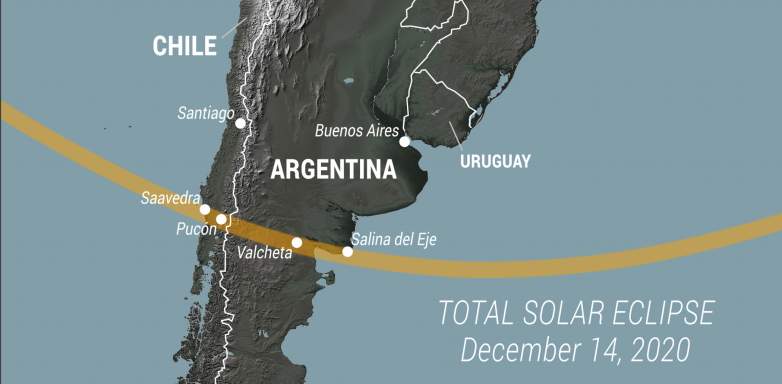
Getty A solar eclipse is pictured.
A total solar eclipse is happening on Monday, December 14, 2020. Unfortunately, only a small part of the world will get to see the eclipse and that doesn’t include the United States. Here’s what you need to know about the map of the eclipse’s path, whether it will be anywhere near you, and what time the eclipse will be taking place.
See a Map of the Eclipse & Times for Totality
NASA provided a map of the eclipse’s path for December 14. You must be within the central path (within the yellow line) in order to see the totality. It will not be visible in the United States, so if you are anywhere in the U.S. then the eclipse will not be near you.
NASA noted:
South America will be treated to an eclipse of the Sun. Anyone within the path of totality can see one of nature’s most awe-inspiring sights – a total solar eclipse. This path, where the Moon will completely cover the Sun and the Sun’s tenuous atmosphere – the corona – can be seen, will stretch from Saavedra, Chile to Salina del Eje, Argentina. Observers in Southern Chile and Argentina outside this path will still see a partial solar eclipse where the Moon covers part of the Sun’s disk. The path of totality has an average width of 56 miles (90 km) and anyone at the centerline of the totality path will have about 2 minutes, 10 seconds of totality not accounting for weather.
Time and Date also provided a map here of the eclipse for comparison. You can search for a specific location on the map there, in order to see if it’s anywhere near where you are. At the very bottom of the map, click on “See how this eclipse looks in your city” to find out if any part of the eclipse will be visible where you are and when, if so.
You can see yet another map of the eclipse here. This map gives you a broader view of the eclipse so you can see it in comparison with a wider angle.
The eclipse will be broadcast online starting at 9:40 a.m. Eastern on NASA’s Media Channel. But it won’t be visible within the United States.
The path of totality will be visible at the following times, according to NASA. (Note that this is just the totality event when the sun is completely hidden and not the timeline for the entire eclipse itself.)
- Teodoro Schmidt, Chile: 1-1:02 p.m. CLST
- Temuco, Chile: 1:02 p.m. CLST
- Gorbea, Chile: 1:01-1:03 p.m. CLST
- Villarrica, Chile: 1:02-1:04 p.m. CLST
- Pucon, Chile: 1:03-1:05 p.m. CLST
- Junin de los Andes, Argentina: 1:06-1:07 p.m. ART
- Ministre Ramos Mexia, Argentina: 1:13-1:16 p.m ART
- San Antonio Oeste, Argentina: 1:19-1:20 p.m. ART
CLST refers to Chile Summer Time (Daylight Saving Time), Time and Date explained. ART refers to Argentina Time, which is three hours behind UTC.
Time and Date will also be hosting a total solar eclipse live stream on December 14. This one will begin at 14:30 UTC, which you can watch below. You can translate this to your local time using Time & Date’s page here. In the Eastern Time Zone it’s 8 a.m. and in the Central Time Zone it starts at 7 a.m., for example.
If you are in the path of totality to watch it live in person and not on a live stream, then you’ll want special glasses to watch in person, NASA explained.
When Is the Next Eclipse?
The next total solar eclipse in the U.S. won’t happen until April 8, 2024. It will have a line of totality crossing Texas, through the Midwest, and over Indianapolis, Cleveland, Buffalo NY, over New England, and passing over Maine and New Brunswick, Canada.
We won’t see the next coast-to-coast solar eclipse in the U.S. until August 12, 2045. So it will be a long time from now.
The next total solar eclipse outside the U.S., meanwhile, will happen on December 4, 2021, but that won’t be visible in the U.S. It will be an unusual eclipse, with totality moving from east to west across Antarctica. This is unusual because most eclipses move from west to east.
There are also annular solar eclipses and lunar eclipses to look forward to in our future.
READ NEXT: The latest COVID-19 deaths, cases, and updates

